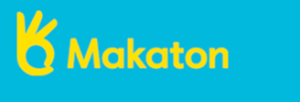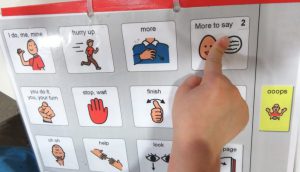Augmentative and Alternative Communication (AAC)
AAC is any communication tool that helps to add to someone’s speech or can be used instead of speech.
AAC includes gesture, signing, objects, photographs, symbols, word boards, communication books and boards as well as voice output communication aids
‘Anyone who has difficulty with “spoken” speech & language skills might use AAC. Sometimes AAC is used temporarily and sometimes it is used long term’ Emily Diaz SLP
You learn AAC the same way you learn language and it takes time!
On the next few pages, you will see different examples of AAC tools. You know your child best, and will always be involved in any decisions about introducing AAC tools to support your child’s communication needs.
Communication boards
Below are examples of different communication boards which have core vocabulary with the written word at the top of the symbol.
As your child’s communication partner, you can help your child to learn this new way of communicating. You will show your child how you can point to a symbol/word to communicate a message. Your child will start to learn this new skill by watching and copying you, especially when they are having fun and being understood.
A communication board is easy to carry and take with you. Your child can have multiple copies of it around home and in school.
Here is an example of a communication board for the specific activity of nursery rhymes. It has core vocabulary and specific fringe vocabulary i.e. the different nursery rhymes.

Here is an example of a core communication board.

Additional vocabulary can be added to a core communication board to create a communication book. This way you child has more reasons to communicate.
Communication Books are used to enable your child to access a wider range of vocabulary and to encourage longer sentences by combining symbols.
Alphabet board

Some children and young people may choose to use spelling to communicate.
Here is an example of an alphabet board. An alphabet board is beneficial for children who are interested in letters and beginning to learn to read.
Makaton

- Makaton is a language programme using signs and symbols to help children to communicate.
- Makaton is designed to support spoken language
- Child can use signs as their voice to say the word aloud at the same time – Makaton does not replace speech, it enhances it
- For children who have experienced the frustration of being unable to communicate meaningfully or effectively, Makaton really can help to ease frustration and enable individuals to connect with other people and the world around them. This opens up all kinds of possibilities.
- Today, over 100,000 children and adults use Makaton symbols and signs to communicate.
- Your child’s Speech and Language Therapist will be able to discuss with you whether Makaton will be helpful for your child, and will demonstrate some signs to start with.

The following links are genuine sources of Makaton signing – please be aware that some sources of signing available online are not necessarily verified Makaton signs, and could be confusing.
Singing Hands have a brilliant range of resources using Makaton, including DVDs, songs and signed stories. Also look Singing Hands up on YouTube – their channel has lots of topic videos of signs to follow.
CBeebies’ Something Special programme uses Makaton in lots of real-life situations. There are additional resources on the CBeebies web site.
On Makaton’s web site there is lots of valuable information. It is also possible to purchase Makaton resources via their shop, which also includes lots of free downloads of information and activities. They also publish a ‘Sign of the week’ on Facebook, alongside other resources.
‘Ten in the Bed’ read by Rob Delaney. Other signed stories read by Justin Fletcher are also available on iPlayer.
Picture Exchange
Below is a picture of what a picture exchange book might look like

The Speech and Language Therapist might recommend your child uses picture exchange to help them communicate their needs and wants.
Choice boards
- Choice boards allow your child to choose their preferred options.
- Below is an example of what a choice board might look like. This particular choice board is for a child to choose what nursery rhyme they want to sing.

- Having a selection of choices on the board, enables your child to develop their picture/symbol recognition skills and identify what they want
- It is important that children have opportunities to make choices throughout their day

First/Then Board – A first/then board can help your child understand what is happening next. eg If you added photos or symbols of park and car to the board, this will prepare your child to leave the park and to get back into the car when it is time to go. You will also say the words ‘first park and then car’ as you point to the symbols on the board.
Countdown Strip – A countdown strip can be used to help a child to transition gradually from what they are doing to the end of the activity, eg ‘the bath is finished in 5..4…3..2..1. the bath is all done’






